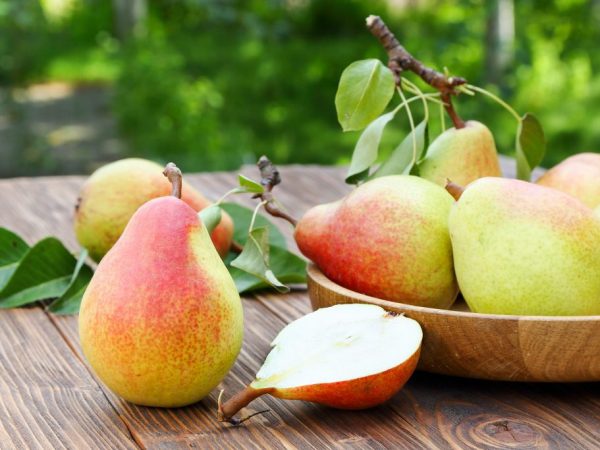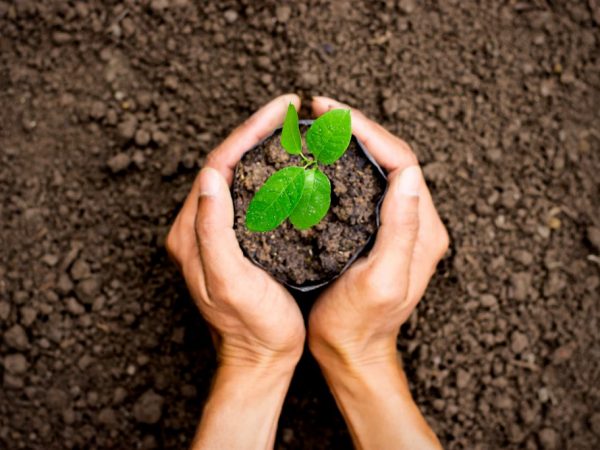Characteristics of the Yantarnaya pear variety
Pear Amber is valued for its high yield rates. The variety is resistant to severe frosts. A detailed description of the Amber pear variety will be considered in the article.

Characteristics of the Yantarnaya pear variety
Characteristics of the variety
Pear Amber is not affected by scab. It tolerates not only low temperatures, but also hot weather.
Main characteristics:
- excellent yield indicator;
- the possibility of transportation without losing the presentation;
- juicy and tasty pods.
According to the description, the Yantarnaya variety bears fruit in the 6-7th year. The yield is high - 30-35 kg from 1 tree. It differs from other species in the late onset of flowering and growing season.
Description of the tree
The Yantarnaya pear tree has a medium size and a pyramidal, medium thickened shape. Most often it bears fruit on ringlets.
The tree grows with oval-round leaves, which are very slightly folded in the middle. The stem organ is long and curved.
Description of fruits
The pear fruit weighs about 200 g. It has a typical pear-shaped shape with slight ribbing.
- covered with a smooth, matte skin of medium thickness;
- unripe fruits have a green-yellowish color, ripe pear turns yellow with a pink-red blush;
- sweet and sour taste.
The fruits are good for desserts. Used to obtain dried fruits. From pears of this variety, you can cook compotes, jam, jam.
Fruits are used both fresh and in the form of various jams. Perfect for baking or jelly-like desserts.

Fruit color is yellow with a pink-red blush
The pulp of the pear is juicy, sweet, spicy. Pear of the Yantarnaya variety is ideal for harvesting for the winter. Freshly squeezed juice from this variety is very tasty, and the jam will turn out to be the most delicate.
The fruits of the Yantarnaya variety can lie until January without losing their taste. Since this variety is late, unripe pears must be ripened. It is necessary that the fruits lie for 2-3 weeks in a warm room.
Care
For planting pears, you should choose loamy or clayey soil. Sandstones don't fit. The pear is quickly taken.
It is recommended to plant the pear on heights.
Watering
In order for the plant to grow quickly and with good yield, it is necessary to water not only from above, but also to the depth of the germinated root. Therefore, within 1 month after planting, it is required to water the seedling 1-2 times a week. For 1 tree, 1 bucket of water will be enough.
If the plant is in a dry environment, you can increase the watering up to 2 buckets. Water then should be 3 times a week.
Mulching
Helps protect garden and cultivated plants from dehydration. For the Amber variety, mulching is limited to a layer of 7-10 cm.
As mulch, you can take:
- straw;
- rotted grass;
- humus;
- special mulch paper.
To carry out mulching, you need to cover in a circle the surface of the soil where the tree grows with mowed grass, peat or sawdust. You can add nitrogen feed to mulch - 50 g per 1 m2.
In spring, manure with straw is used for mulching.Mulch creates optimal conditions for growth, productivity and helps to obtain juicy fruits.

For planting pears, you should choose loamy or clayey soil.
Pruning
Pruning the plant increases fertility, growth and crown of the tree. Dried or unwanted branches should be pruned. It is recommended to do this in autumn or spring, when the plant does not grow rapidly. But if it is urgent to remove the branches, then this can be done in the same way both in summer and in winter.
Plants up to 1 year old are pruned to branch the crown, so only 23% of the branch is removed. From 2 years old, the seedling is shortened by 25 cm, but only near the trunk, and the side branches by 7 cm. Older trees from 6 years and more should be cut once every 3 years. The best tools for this procedure are pruning shears or garden knives.
Spraying the plant with fertilizers. To do this, take a solution of 2% sulfate or 3% superphosphate. It will make the pear more fruitful and strong.
Loosening
Loosening is a maintenance method that improves the ground cover. For the pear, medium loosening with a clear regularity is recommended.
Helps get rid of weeds. An alternative to loosening can be sowing a lawn or erysipelas with regular mowing.
Pests and diseases
The pear is resistant to pests, but improper care can cause the tree to become infested. The most common are:
- Hawthorn. The insect quickly eats up all flowers and greens. After itself, it leaves only bare branches. To combat them, use insecticide pollination, or digging up the soil.
- Winter moth. Eats all the buds and flowers. For spraying, insecticides are used: Chlorophos, Zolon, or Oleocobrite.
- Pear gall midge. To treat the plant, use Chlorophos, Phosphamide or Metaphos.
- Pear flower beetle. Harmful to flower buds, leading to sterility of the tree. Timely cleaning the bark in the spring or installing glue belts will help to destroy the invasion.
- Powdery mildew. It is characterized by a white bloom on the leaves, as a result of which they dry out. For prophylaxis, dried shoots are removed and sprayed with a mixture. Take 50 g of soda, 10 g of liquid soap and dilute in 10 liters of water.
- Fruit rot. The disease is provoked by the mushroom Monilia fructigena. The disease can be determined by the brown spots on the fruit. It is recommended to remove the infected fruit and spray the plant. To do this, take a Bordeaux mixture 1%.
Conclusion
Thanks to its strong skin, the Yantarnaya Pear variety is suitable for long-term transportation. Yield indicators, unpretentious care and taste of the fruit make this pear one of the most popular among gardeners.


